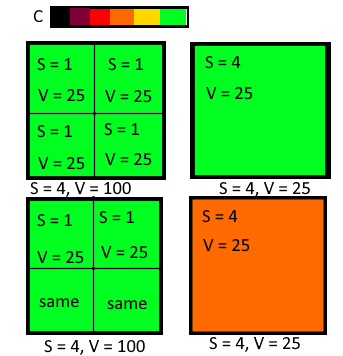So, what do I mean by area based maps? I mean maps which show some value per pixel instead of per location. So, if c = location color on a map, s = location area and v = location value (population, devastation, development, etc. depending on map mode), k = some coefficient, in per-location maps c = v * k while in per-province ones c = (v / a) * k.

For example, here first four location each have a size of 1 and population of 25 while another one has size of 4. If we insert these values into the formula we get that colors of both locations will be the same even though population density in first four locations is obviously bigger. Note I'm not talking about area of arable land, real-life area, etc. I'm talking about amount of pixels player sees in game. If we insert the same values into the second formula we get c = 25 / 1 * k and c = 25 / 4 * k or c = 25 * k and c = 7.5 * k, so bigger location with the same population looks darker.
How can both maps can be used? The location-based one is better for, well, location level stuff, like checking which location is better to take in a peace deal or whether it's possible to build a new city (as amount of pixels has no impact on city size). Area-based maps, on other hand, are more useful in less "zoomed in" situations. For example, when deciding broadly which area to invade or checking how developed other nations are just by looking at their color in corresponding map, which may be much less useful in cases like I described previously (where two areas of the same size are shown as the same color even though one has 100 population and other only 25 due to different location density).
Of course, I don't want full replacement of per-location maps with per-area ones: the former are still useful in most cases. But making the latter an option would be useful too.
Edit: rewrited the post.

For example, here first four location each have a size of 1 and population of 25 while another one has size of 4. If we insert these values into the formula we get that colors of both locations will be the same even though population density in first four locations is obviously bigger. Note I'm not talking about area of arable land, real-life area, etc. I'm talking about amount of pixels player sees in game. If we insert the same values into the second formula we get c = 25 / 1 * k and c = 25 / 4 * k or c = 25 * k and c = 7.5 * k, so bigger location with the same population looks darker.
How can both maps can be used? The location-based one is better for, well, location level stuff, like checking which location is better to take in a peace deal or whether it's possible to build a new city (as amount of pixels has no impact on city size). Area-based maps, on other hand, are more useful in less "zoomed in" situations. For example, when deciding broadly which area to invade or checking how developed other nations are just by looking at their color in corresponding map, which may be much less useful in cases like I described previously (where two areas of the same size are shown as the same color even though one has 100 population and other only 25 due to different location density).
Of course, I don't want full replacement of per-location maps with per-area ones: the former are still useful in most cases. But making the latter an option would be useful too.
Edit: rewrited the post.
Last edited:
- 4
- 3
- 1

